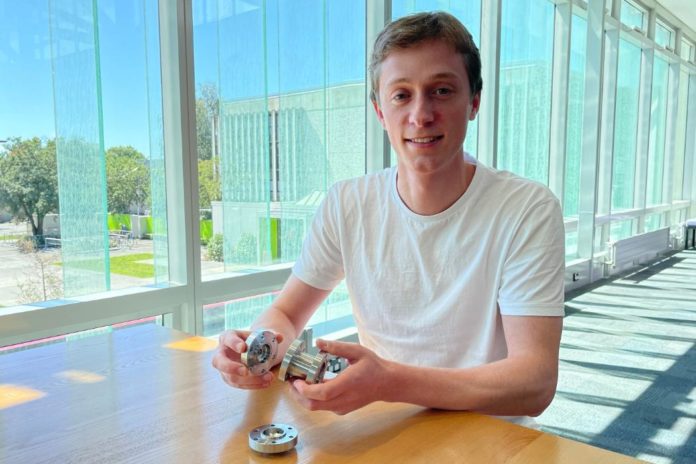
The three things Reid is trying to overcome using the gyroid in the catalyst bed is loss of catalyst, a large pressure drop, and maximising thrust balanced against the concentration of hydrogen peroxide – some catalysts have a low melting point relative to the temperature of the gases coming out.
Fascinated with everything that in the intersection of 3D printing and aerospace, Chemical and Process Engineering PhD student at University of Canterbury, Simon Reid has been working lately on a 3D printed catalyst bed that will enable more efficient use of concentrated hydrogen peroxide (a bleaching agent usually called oxygenated water).
The solution would be a propellant for rockets requiring low to medium thrust. The scientific term for this bleaching agent is Hydrogen peroxide. The latter would be a much less toxic alternative to hydrazine, a commonly used aerospace propellant for low to medium thrust applications.
Hydrazine is a suspected carcinogen and requires additional safety equipment and protocols when in use which drives up the cost of using the fuel. Alternatively, hydrogen peroxide is largely non-toxic to humans and has common household uses such as bleaching hair or to clean wounds.
However, to generate thrust from hydrogen peroxide a catalyst is needed. Often a precious metal, like silver or platinum, the catalyst rapidly decomposes hydrogen peroxide into an energetic gas. In Simon’s 3D printed design, the surface of the ceramic catalyst bed is coated with the catalyst for hydrogen peroxide to pass through.
“By passing liquid hydrogen peroxide over a catalyst bed it speeds up the decomposition reaction. The reaction disassociates the molecule, turning it into water and oxygen. It is the breakup of the molecule that produces a large amount of energy and heat. The heat vaporises the water and results in a high temperature gas – passing the hot gas through a nozzle provides thrust,” Reid explains.
The aim of his research is to refine the design of the catalyst bed to maximise the generation of thrust from hydrogen peroxide while limiting the loss of catalyst from the bed and keeping the components light.
Working with Callaghan Innovation, Simon is using 3D printing to generate novel catalytic structures that have better properties – lower pressure drop and use different catalytic materials to improve the performance of the thrusters.
“The shape I’m using is called a gyroid. It’s a mathematical shape, more optimal for catalytic processes, and cannot be manufactured using traditional techniques.”
The three things Reid is trying to overcome using the gyroid in the catalyst bed is loss of catalyst, a large pressure drop, and maximising thrust balanced against the concentration of hydrogen peroxide – some catalysts have a low melting point relative to the temperature of the gases coming out.
“Dawn Aerospace, who are a local collaborator on the project, currently use hydrogen peroxide as a propellant for their reusable space plane that will deliver satellites into orbit. The catalyst they use is quite rudimentary and has been around since the 1960’s, that is what the research is trying to improve,” says Simon.
Simon will begin testing the efficiency of the newly designed catalyst bed soon, comparing the results against existing designs.
“Only a few companies are seriously considering hydrogen peroxide. Hopefully by designing these efficient catalysts we can promote it as a viable alternative to hydrazine, and help make the aerospace industry that little bit safer.”
Remember, you can post free of charge job opportunities in the AM Industry on 3D ADEPT Media or look for a job via our job board. Make sure to follow us on our social networks and subscribe to our weekly newsletter : Facebook, Twitter, LinkedIn & Instagram ! If you want to be featured in the next issue of our digital magazine or if you hear a story that needs to be heard, make sure to send it to contact@3dadept.com





